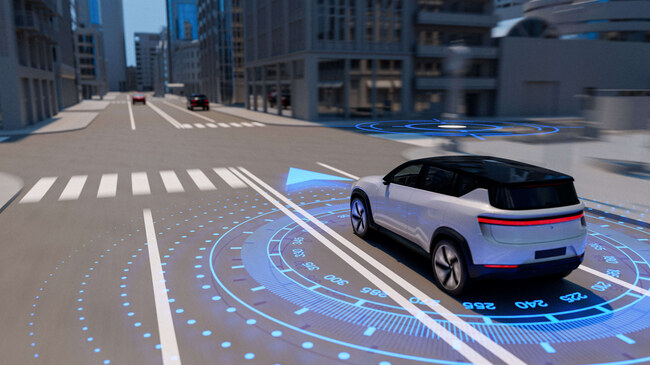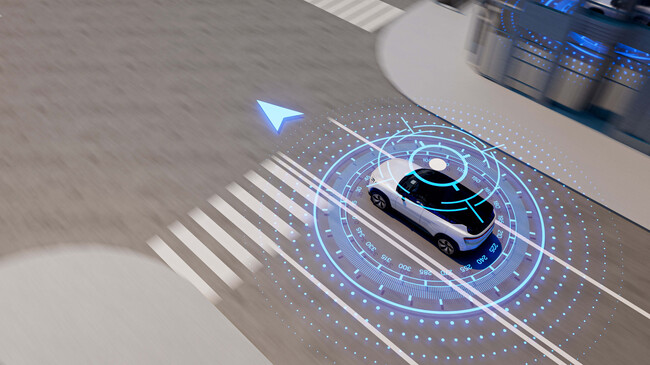Absolute v.s. Relative Position
Ramya Sriram
7 min read
27th Sep, 2023

What is the difference and why does it matter?
Critical to scaling ADAS into urban environments, GNSS provides a key sensor localising you on the road. Absolute location is determined directly in relation to the satellites, velocity and time and is essential to making automated driving safer, more accurate and reliable.
In this blog, Manuel Del Castillo, our GNSS expert, explains the difference between absolute and relative position for the future of autonomy and why it matters.
Absolute and relative positioning – what’s the difference?
In its simplified form – absolute positioning determines the position of a receiver directly with respect to the Earth’s surface, whilst relative positioning determines the position of a vehicle relative to another known point.

Absolute navigation relies on the precise location from GNSS satellite positioning. We use the GNSS receiver to give us our absolute position to lane level and this gives us a critical cross check to the other suite of sensors.
Relative position doesn’t tell us where we are, it simply provides us a reference of where we are – relative to something else. This could typically be a previous position or something you don’t want to hit, a wall or another vehicle. These objects will usually be transient, and so cannot be plotted on a map.
In consumer devices, we typically use sensors to aid our decision making, to support our perception and blind spots. Think how much easier reversing into a tight space is with your car’s ultra-sonic sensors and rear-facing camera? However, to do this well, we are reliant on the power of our natural perceptive sensor-fusion system. And by this I mean our natural ability to navigate hugely complex environments with ease.
When we start to abstract humans out of the control loop, we remove this incredibly powerful perceptive computer and have to find ways to make up for this loss in more specialist ways. We are very good at being able to assess complex environments and make adjustments for the failure of a system.
These are the types of challenges that need to be solved if we are ever going to fully rely on autonomous systems.
Control: How do we maximise the amount of time an autonomous vehicle is able to be in control?
Competence: How do we provide a level of system performance that maximises performance and safety?
Confidence: How do we ensure the integrity of data through a system?
Complexity: How do we achieve all the above goals with a manageable level of complexity?
Control: How do we maximise the amount of time an autonomous vehicle is able to be in control?
Competence: How do we provide a level of system performance that maximises performance and safety?
Confidence: How do we ensure the integrity of data through a system?
Complexity: How do we achieve all the above goals with a manageable level of complexity?
As with any digital sensor, it can only interpret its own signal for its own discrete job. However in average scenarios there may be a need to cross reference the sensors against each other. As an example, understanding if there is something close enough or far away from my reversing sensors could require multiple sensors.
If you think back to the ‘reversing a car’ scenario, whilst the ultrasonic sensors are used to perceive distance and can tell us a relative distance away from a solid object and its bearing, they do not define what the object is. A reversing camera can be a fantastic cross-check in this example as the sensor responsible for picking up a false reading, or to help provide further confidence and further direction.
Absolute positioning with GNSS
We do this with GNSS. We use the GNSS receiver to give us our absolute position, to give us a critical cross check to the other suite of sensors. For example; when using visual odometry from cameras to position on an HD map which could be out of date or inaccurate, a GNSS cross-check either provides confidence or flags a potential error. This is a critical function, which enables the system to detect when its positioning systems are unreliable. For GNSS, multipath is the big unsolved problem. When the view of the sky is obscured, the sensor might only receive signals which are reflected and take ‘non-line-of-sight’ paths to the receiver. This problem is at its worst in built up citIes with high skylines like London, New York & Shanghai.
What’s next?
Reliability matters. Reliability provides confidence in your sensors’ measurements. Confidence in your sensors breeds higher competence, allowing for devolved control to the autonomous system and in turn allowing a higher percentage of the total driving time to be hands-free.
How can we help?
At FocalPoint we believe in a more autonomous future and that all sensors need to increase their measurement quality and integrity. Our Supercorrelation (S-GNSS) technology is the only methodology to determine the angle of arrival of a satellite signal. By doing this we create our own critical cross-checks inside our own sensor and come as close to determining truth for ourselves as is possible at very low system complexity. We determine exactly which signals we want to listen to, exactly which ones we are listening to and discard the rest. That means that what is propagated through an S-GNSS receiver is now more reliable.
For further insight into S-GNSS, please contact us.







